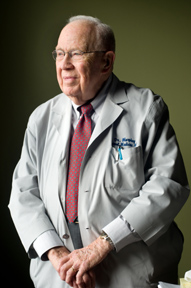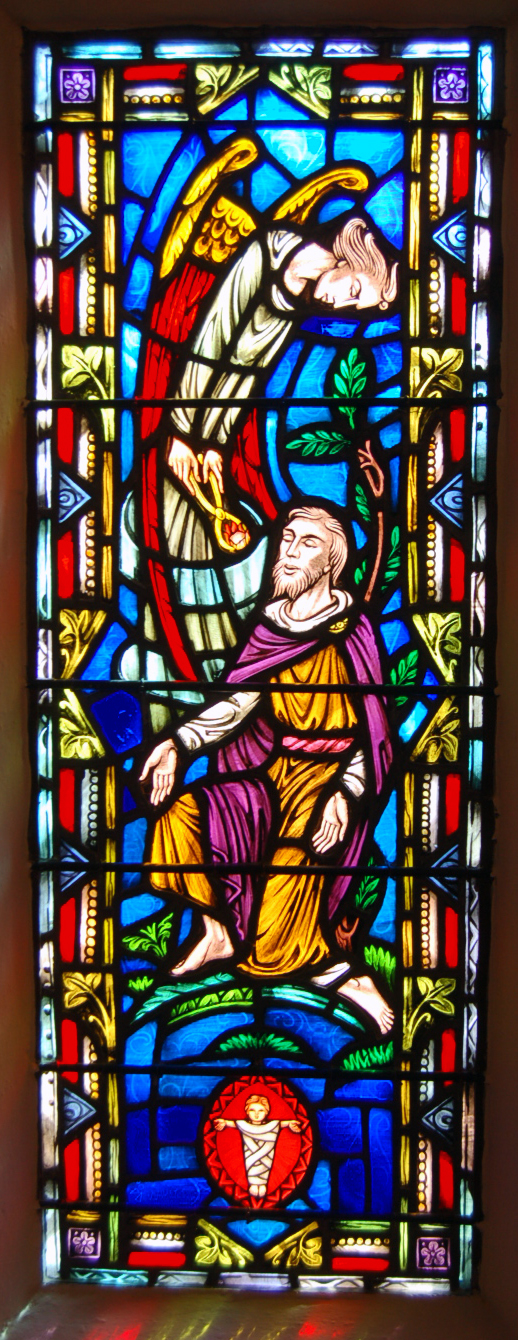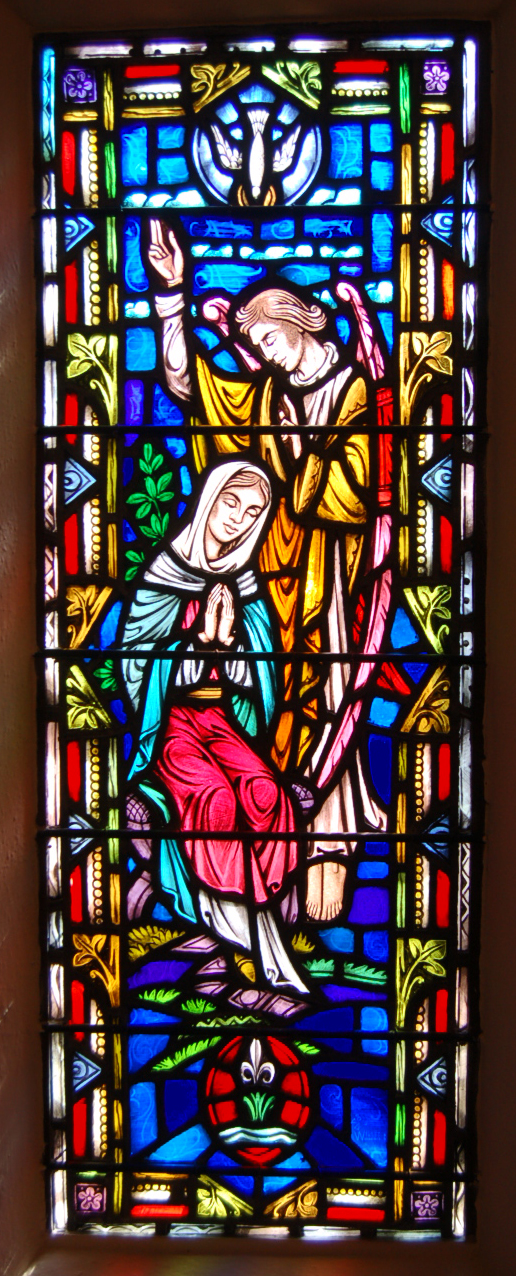FPC History 101
The late Dr. Eugene Murphey authored an extensive series of articles covering many aspects of First Presbyterian’s history for our monthly newsletter, The Tower.
These were published from December 2004 through November 2007. In total, twenty-seven articles were composed and offered by Dr. Murphey relaying informative and detailed information about our church and the Presbyterian faith.
In his first article, the first paragraph, Dr. Murphy instructs, “… you are expected to remember and pass on the information to family, friends, and visitors whenever the opportunity occurs.”
Being a collection of facts and information too wonderful not to share on the First Presbyterian site, it is with pleasure that these articles be passed along as instructed by Dr. Murphey.
History 101.01
The below article was written by Dr. Eugene Murphey and was published in The Tower newsletter of Decemebr 2004. Dr. Murphey gives a history of these missionaries and their importance to the Presbyterian church. The below is but one part of Dr. Murphey’s research. Additional articles will be added soon!
![]()
[responsivevoice voice=”US English Female”]
No exam, no homework, and no grades in this and upcoming sessions dealing with our local church history, but you are expected to remember and pass in the information to family, friends, and visitors whenever the opportunity occurs.
Let’s begin by talking about our wonderful church facility and specifically about the beautiful stained glass windows that grace three walls of our sanctuary. These windows were commissioned by First Presbyterian in 1969 and were designed and installed in 1970 by the Willet Company of Pennsylvania with the assistance of Dr. Arlan Dirlam, church architect specializing in Gothic architecture. His window Mrs. Grace Baker Dirlam, a native of Tupelo, still lives here. Dr. Dirlam also redesigned the sanctuary chancel area, and he and Dr. Henry Lee Willet were present and participated in the dedication ceremony January 18, 1970.
Stained glass dates back to medieval times, and much of the same process, although refined over several centuries, is still used today in the production of stained – or art glass – as it is more appropriately called.
The windows in the east and west walls of the nave tell the story of the life of Jesus Christ, starting from the first rear windows on the epistle or east wide and moving to the front and across to the gospel or west side and back to the rear of the nave.
As we approach Christmas season it is appropriate that we consider the first three windows depicting in chronological order the prophecy by Isaiah of Christ’s coming. The prophet is depicted having his lips purified with a burning coal by a cherubim, and below is the Holy Child with arms outstretched to the world.
The second window, the Annunciation, shows the dove of the Holy Spirit descending and Angel Gabriel appearing to the Virgin Mary to announce the coming of the Christ Child.
The third or Nativity window shows the familiar manger scene in Bethlehem with the star above and Mary and Joseph watching over the newborn baby. Below them is the Lamb or Agnus Dei symbol of God the Son. The Lamb holds a cross predicting Christ’s crucifixion.
As we view the windows let us not only enjoy them as remarkable and beautiful religious art objects but also use them to remind us of the wonderful symbols and events of our own Christian heritage. In future issues of The Tower, we hope to offer you more information on the sanctuary windows and other interesting information about our church and its history.
[/responsivevoice]
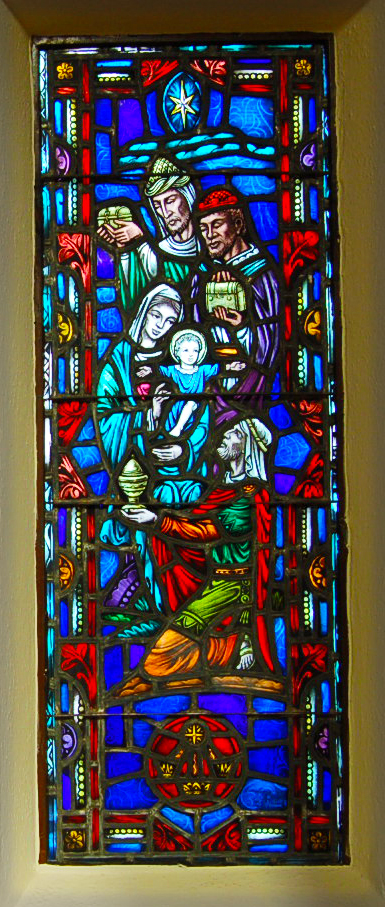
History 101.2 – The Epiphany
Written by Dr. Eugene Murphey and published in The Tower, January 2005.
![]()
[responsivevoice voice=”US English Female”]
Ready or not, here we are again with another serving of history and hopefully interesting facts about First Presbyterian Church. In our first session, we reviewed the history of the planning and installation of the stained glass windows in the church nave. Then we covered the story of the prophecy, annunciation, and birth of Christ presented by the first three windows in the east wall.
Before we proceed with our tour, let me explain that all of the windows in the nave were subscribed by members of the congregation and dedicated as memorials or in honor of family members or friends. The Session wisely chose to avoid dedication labels on the windows but rather recorded the dedications in a book located in a display case on the right side of McFadden reception hall at the rear of the sanctuary.
The Session also chose to subscribe to a single window outside the nave. It is found in the church entrance foyer or narthex. This window was dedicated by the Session ‘to the memory of the unnamed faithful of the church.’ The window illustrates the Acts of mercy as related in the twenty-fifth chapter of Matthew, Please take a moment to observe this small jewel of stained glass as you enter or leave the church.
One other deviation before we re-enter the sanctuary. If you have wondered about the three stained glass panels in the wall of the stairwell going to the balcony, these originally occupied the south wall of the chancel area and were retired to their present location when the larger chancel panels were installed.
Now back in the sanctuary, we continue along the east wall to the fouth window which displays The Epiphany, the wise men followed the star and coming to adore the Christ child with gifts of gold, frankincense, and myrrh. This also signals the showing of Christ to the Gentiles and follows the statement on John 1:45 – ‘Him of whom the prophets did write.’ A symbol of three crowns is at the bottom of the panel. This completes the wonderful Christmas story just in time for our own celebration of the birth of Christ.
In the near future, we will look at the remaining side windows and at the three beautiful panels in the back of the chancel area. Meanwhile, take a little time to study the windows and appreciate the historical events they represent.
[/responsivevoice]
-Eugene M. Murphey, M.D.
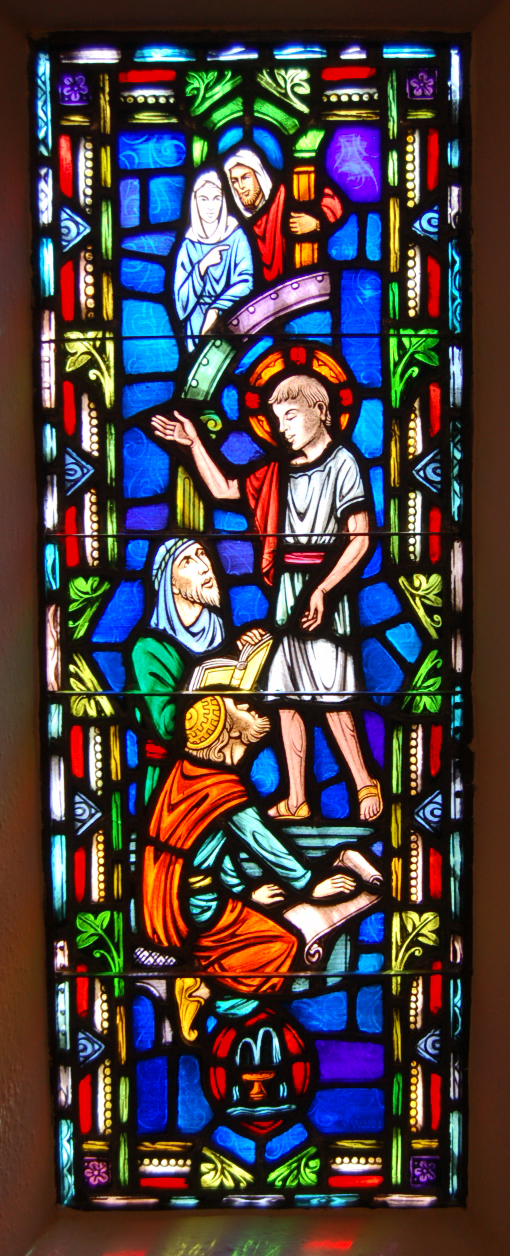
History 101.3
The below article was written by Dr. Eugene Murphey and was published in The Tower newsletter of February 2005.
![]()
[responsivevoice voice=”US English Female”]
In the twenty-first century, we live in a world of high quality moving pictures, video and DVD images and all kinds of media manipulations. Sometimes we are overwhelmed by the plethora of visual records, and yet when we view art in still form such as a great painting or a photograph, we still can be moved, inspired or even changed by these images. This is certainly the case with the stained glass windows in the sanctuary of First Presbyterian Church. These beautiful panels were placed there not just to add beauty to the sanctuary but also to tell the wonderful story that is basic to our Christian faith.
The earlier issues of The Tower we have looked at the windows depicted the prediction, the birth, and the recognition of Jesus Christ as the Son of God on earth. Now we proceed down the east wall of the nave to see a representation of the earliest record we have of Christ’s youth when, as we are told by Luke 2:41-52, Jesus was taken by his parents to the Passover Festival in Jerusalem. After three days, when the festival was over, villagers started their return journey to Nazareth and di not realize that their oldest son, then twelve years old, was not with them. Mary and Joesph returned immediately to Jerusalem and searched for him for three days before finding him in the Temple sitting with the teachers, listening and talking with them and amazing them with his intelligence and knowledge of the scriptures. His parents were very happy to find him but scolded him, his mother asking, ‘Son, why have you done this to us? Your father and I have been terribly worried trying to find you.’ Luke tells us that Jesus answered them with two puzzling questions. ‘Why did you have to look for me? Did you not know that I had to be in my Father’s house?’ They did not understand his answer, but they returned to Nazareth where he was obedient to them, and Mary treasured all these things in her heart. We have no other record of Jesus’ youth after this except that he grew in body and wisdom, gaining favor with God and men.
This is the theme of the fourth window where we see Jesus speaking with the Jewish teachers in the Temple. In the background, Mary and Joseph are entering the Temple and finding their supposedly lost son, A symbol for the fountain of wisdom is located at the bottom of the panel.
[/responsivevoice]
-Eugene M. Murphey, M.D.

History 101.4 – Baptism
The below article was written by Dr. Eugene Murphey and was published in The Tower newsletter of March 2005.
![]()
[responsivevoice voice=”US English Female”]
When we Presbyterians think of baptism, we generally think of the symbolic act of water being sprinkled or dripped on the head of the recipient while the minister, preacher, or priest repeats the scripture-based words and promises. Most of s are not overly concerned with the physical act of baptism – whether we are sprinkled, sprayed, dipped or even immersed. Instead, we recognize the act of baptism as a symbol of spiritual cleansing and recognition that we have been called by God, claimed by God, and that uniting with Jesus Christ we have been freed from sin and death. These things represent a covenant with God that we ourselves acknowledge or that is acknowledged for us by our parents or guardian if we are not old enough to do so.
Before Jesus began His ministry he apparently realized his own need for an outward sign or covenant that he was one with God in body, mind, and spirit. He had heard in Nazareth that his cousin John, son of Zechariah and Elizabeth, had come out of the wilderness of Judea and had become a powerful preacher and prophet to a great number of people in the region. He was said to baptize and demand repentance of sins and a return to God. John has been described as a powerful man dressed in animal skins, an ascetic who led a life of contemplation and rigorous self-discipline and self-denial for religious purposes. John had been asked if he were the coming Messiah but is said to have replied that he was only the herald, the messenger telling of one yet to come.
Jesus sought out John and, finding him on the bank of the Jordan river preaching to the multitudes asked John to baptise Him. You will remember that John told Jesus that He (Jesus) should instead baptize him (John), but Jesus prevailed. According to scripture, after the brief ceremony, a white dove alighted on the shoulder of Jesus, and many in the crowd heard a voice from heaven say, ‘This is my beloved son, in whom I am well pleased.’
This baptism is the theme of our next stained glass window in the east wall of the sanctuary, and for those who have expressed uncertainty about which side of the nave is east or west, east is to the left when facing the chancel area and west is to the right. John is seen pouring water from a shell on Jesus’ head as they stand by the river Jordan. John holds in his left hand a staff topped with a cross symbolizing the prophecy of Jesus’ death on the cross. At the top of the panel is the descending dive representing the Holy Spirit. Ath the bottom is a shell pouring water in which there is a fish. Behind this is a chi-rho (XP) symbol, the ancient monogram of Jesus Christ.
This window represents the events immediately preceding the beginning of Christ’s earthly ministry. From this point, He followed John’s example and made his way into the wilderness, the bast desert area of Quarantaria so that he might face and overcome temptation Himself before telling other people what they must do. After forty days of self-searching, praying, fasting and resisting temptation by the devil, Jesus returned to civilization and again sought our his cousin John, who this time proclaimed Him the Son of God, the one who takes away the sin of the world!
[/responsivevoice]
-Eugene M. Murphey, M.D.
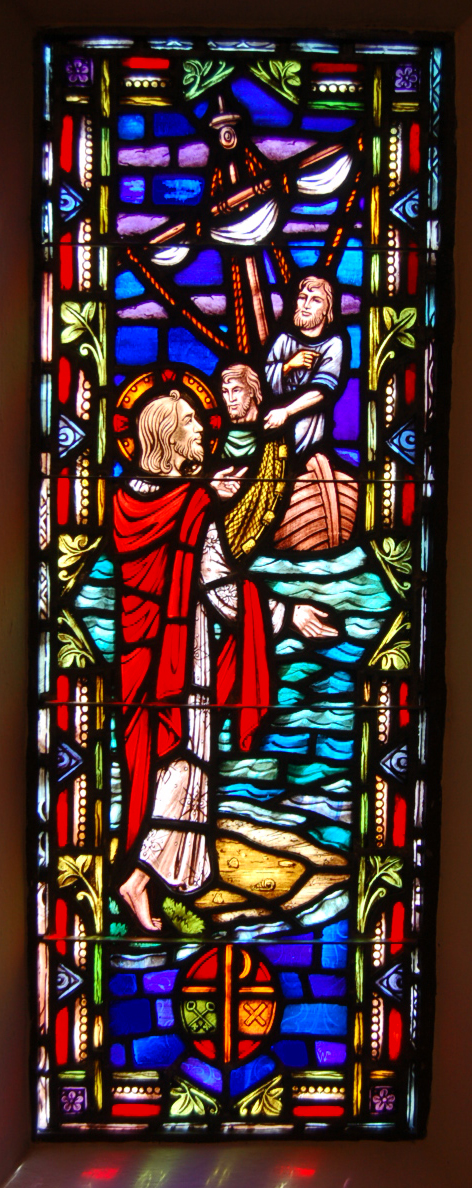
History 101.5 – Calling of the Fishermen
The below article was written by Dr. Eugene Murphey and was published in The Tower newsletter of May 2005.
![]()
[responsivevoice voice=”US English Female”]
The scriptures tell us that Jesus repeatedly resisted temptations by the Devil during his forty days’ sojourn in the desert, and upon returning to his home in Nazareth he learned that John the Baptist had been imprisoned and later killed. According to Luke, Jesus taught and preached in Nazareth and later in Capernaum in Galilee. It was in the latter city that he encountered the ned who were to become his first disciples. Jesus was walking on the shore of Lake Gennesaret, trying to preach to a multitude of people when he encountered two fishermen brothers, Simon (later called Peter) and Andrew washing their nets at the water’s edge after an unsuccessful night’s fishing. He asked the brothers to take him in their boats a little way offshore so that he might better talk to the crowd that had been pressing upon him. They did as he requested, and when his teaching was finished he told the skeptical fishermen to let down their nets once more. To their disbelief and amazement, they brought in such a heavy load of fish that they had to enlist the help of two other partners in another boat to pull up the bursting nets. These men, also brothers, were James and John, sons of Zebedee.
Simon Peter was so overwhelmed by this amazing turn of events that he fell to his knees begging Jesus to ‘Go away from me, Lord, because I am a sinful man!’ Luke tells us that Jesus reassured him and the others not to be afraid, telling them, ‘You will be fishers of men.’
This wonderful story from the beginning of Jesus’ ministry is depicted in the beautiful fifth stained glass window panel on the left side and near the front of the sanctuary. jesus is standing on the lake shore speaking to Simon Peter and Andrew in their boat. At the bottom of the panel is a chi-rho with Peter’s symbolic crossed keys (the keys to the Kingdom of Heaven) and Andrew’s X-shaped cross (he was crucified and burned to death on such a cross).
[/responsivevoice]
-Eugene M. Murphey, M.D.
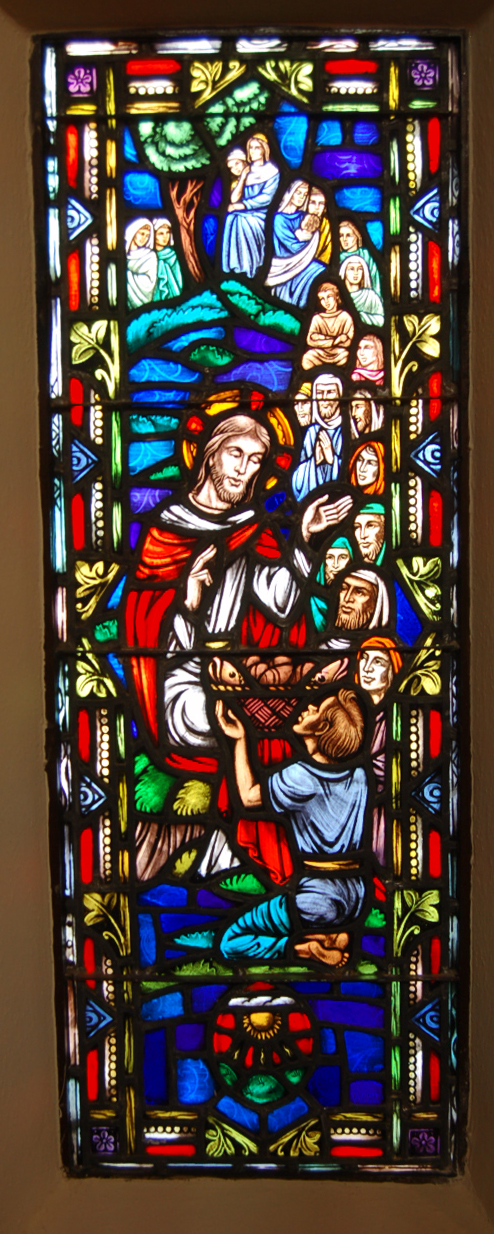

History 101.6
The below article was written by Dr. Eugene Murphey and was published in The Tower newsletter of June 2005.
![]()
[responsivevoice voice=”US English Female”]
The dictionary definition of a miracle, derived from the Latin word miraculum, is ‘an event or action that apparently contradicts known scientific laws: as the miracles in the Bible.’ The New Testament has recorded many of the remarkable and miraculous actions of Jesus during his earthly ministry, and two of them are the subject of our next two stained glass windows. These are the first two panels at the front of the sanctuary on the west (right hand) side.
The first panel depicts the scene when Jesus was preaching to a crowd of about five thousand people on the northern shore of the Sea of Galilee. Toward evening he realized that many were hungry and had brought little or no food with them, so he asked his disciples to survey the crowd and find whatever food was available. Disappointedly, they reported finding only a young lad who has brought five barley bread loaves and two small fish, hardly enough to feed even two people., much less this multitude. Without doubt or hesitation Jesus took the meager supply, blessed it and distributed portions to all his disciples; they, in turn, fed all the people on the hillside. None of this divine abundance was wasted; Jesus had the disciples gather all the remaining scraps of food, which filled twelve baskets. The people were so amazed by the miraculous act that they proclaimed. ‘Surely, this is the Prophet who was to come into the world!’ (John 6:14). The window shows the multitude behind Jesus as he accepts loaves and fishes from the young lad. The symbol at the bottom of the panel is the sun setting on this wonderful event.
The adjoining window shows two more of the miracles Jesus performed during the early part of his ministry. Behind him in the figure of a woman who had suffered from a bleeding illness for twelve years. As the crowds pressed upon him, she touched the edge of his garment and was immediately healed. Jesus was instantly aware that his healing power had gone out to her. When she confessed what had happened, He said, ‘My daughter, your faith has made you well. Go in peace.’ (Luke 8:48). The window combines this miracle with that of a crippled man who kneels before Jesus and is also healed.
The medical symbol of a caduseus appears at the bottom of the panel to signify the healing ministry of Jesus.
It is of special interest that this stained glass panel was dedicated to the Feemster family and especially to both Doctors Lucian Carl Feemster, Senior, and Junior, who were prominent surgeons in Tupelo during the 1900’s, and whose family home previously occupied the southeast corner of our present church property. This house provided extra Sunday school rooms and a social parlor for the church before construction of our Fellowship Hall. The later home of Dr. Feemster, Jr., on the northeast corner of the property behind the wall still serves our scout troop.
[/responsivevoice]
-Eugene M. Murphey, M.D.
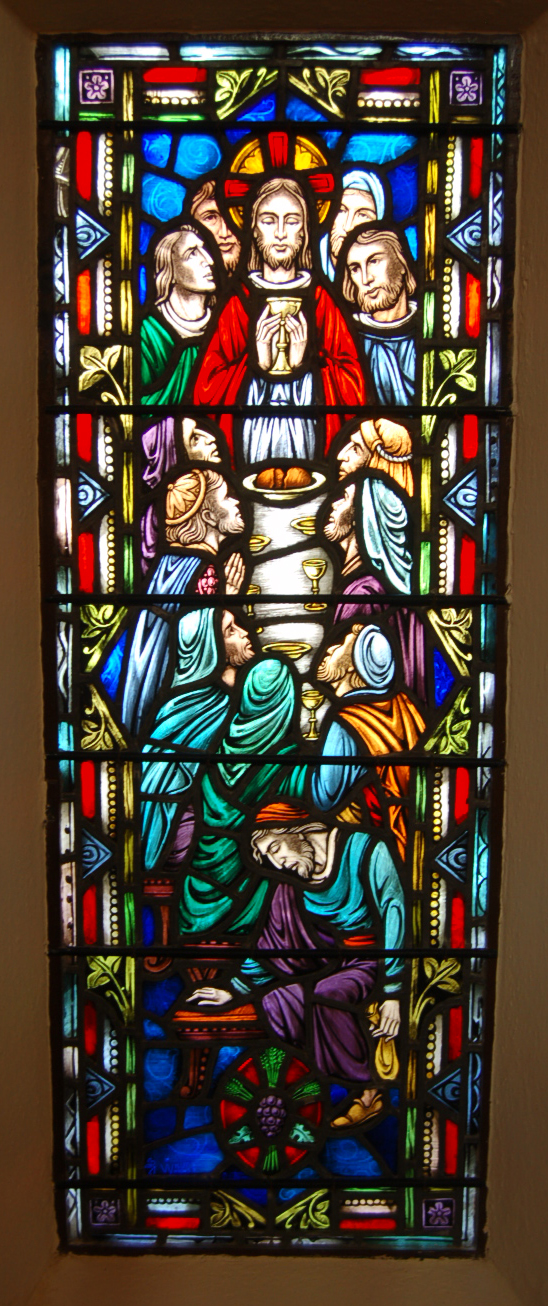
History 101.7
The below article was written by Dr. Eugene Murphey and was published in The Tower newsletter of August 2005.
![]()
[responsivevoice voice=”US English Female”]
Communion, Holy Communion, the Lord’s Supper and the Eucharist are all names applied by various Christian faiths and denominations to represent the act of sharing blessed or consecrated bread and wine with each other as prescribed by our Lord Jesus Christ shortly before his death. The disciples tell us in Holy Scripture that while they were eating a Passover meal, Jesus blessed portions of bread and wine, which he gave to them as representative of His body soon to be broken and His blood soon to be shed for them and for all the world. This, he told the disciples, represented God’s new covenant sealed with his blood.
Through the centuries faithful Christians have continued to follow his command to ‘do this in remembrance of me until I come again.’ The format and frequency of this service may vary in different denominations, but the meaning and dedication remain the same regardless of how and when it is done.
The first Christian communion service is well depicted in the stained glass panel in the west wall of the sanctuary. Jesus is shown surrounded by twelve Apostles. He is holding the cup and bread for the ritual meal. Judas, already identified as our Lord’s betrayer, is seen guiltily crouching at the foot of the table. The symbols of grapes and wheat at the bottom of the panel represents the bread and wine of the communal meal.
This window was given in memory of William B. Fields, long time FPC member, and elder, by his son Thomas B. Fields and his daughter, the late Elizabeth (Betty Feilds) Reed.
[/responsivevoice]
-Eugene M. Murphey, M.D.
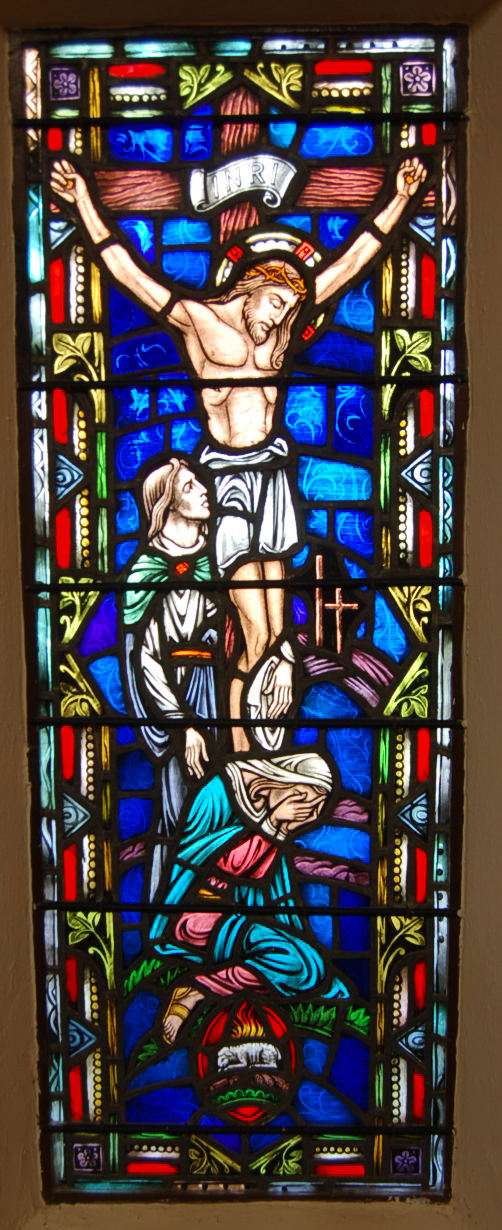
History 101.8 – The Crucifixion Window
The below article was written by Dr. Eugene Murphey and was published in The Tower newsletter of September 2005.
![]()
[responsivevoice voice=”US English Female”]
No matter how you look at it, a picture, statue or icon of Christ’s crucifixion presents a terrible and horrific image of his suffering and death on a cross. Painters, sculptors, movie directors and even stained glass window makers have through the ages tried to depict this event, but even the best can only give us a limited view of that terrible day at Calvary. Nevertheless, these visual media still serve to remind us of the supreme sacrifice our Lord made for us all.
The portrayal of this event in stained glass by the Willet Company in Pennsylvania is seen in the next window panel in the west wall of our sanctuary. The crucified and dying Christ hanging on the cross is embraced by his beloved disciple John. Mary, the mother of Christ, sits weeping at the foot of the cross. We are told in scripture (Luke 23:34) that as he died Christ prayed, ‘Father, forgive them for they know not what they do.’
The other two crosses of Christ’s companions in this event are seen in the background, and below Mary is a sacrificial lamb referring to the sacrifice of Isaac, a type of crucifixion.
This window, like all others in the sanctuary, is dedicated to the glory of God and faithful members of the church. The late Raymond and Betty Purnell gave this particular panel in memory of his mother, Mrs. Daisy B. Purnell, a long time choir member of FPC.
[/responsivevoice]
-Eugene M. Murphey, M.D.
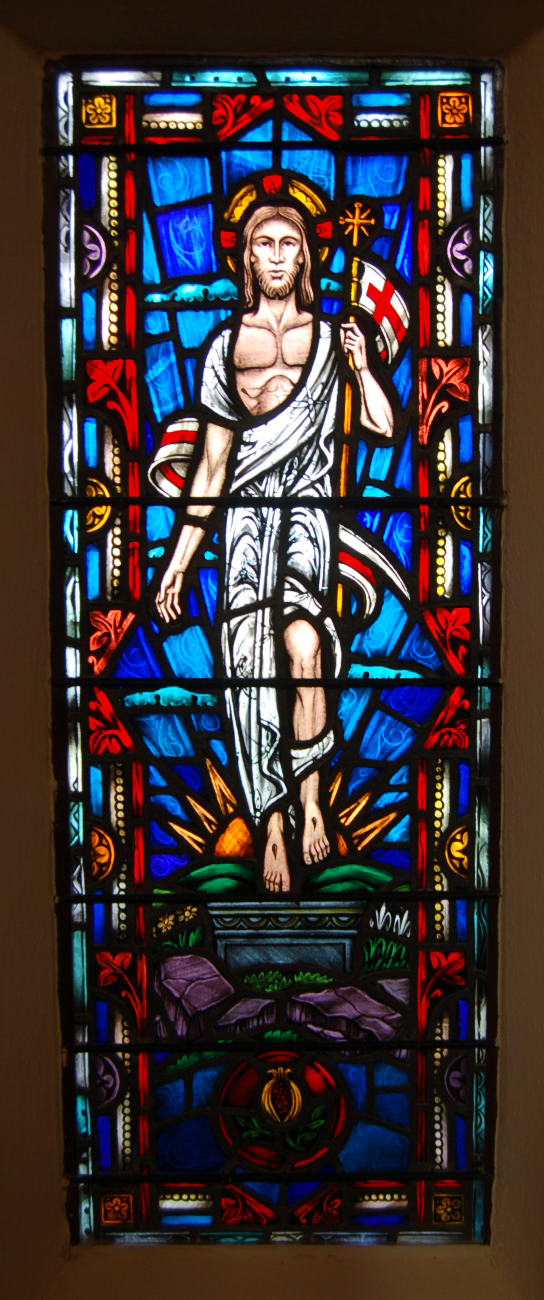
History 101.9 – The Resurrection
The below article was written by Dr. Eugene Murphey and was published in The Tower newsletter of October 2005.
![]()
[responsivevoice voice=”US English Female”]
The resurrection of Jesus Christ as depicted in the fifth window of the west wall of the church sanctuary presents another mystery that has puzzled and confounded even the most learned theologians, as well as the least learned common Christians and even non-believers through the centuries. We know that Christ died on the cross at Calvary shown in the previous window. His body was buried in a sealed tomb and guarded by soldiers to prevent theft or the tampering. This is all accepted facts, well
followers, synagogue leaders, and government officials. yet, three days alter his body disappeared, leaving behind his burial garments and two messengers from God announcing that Christ was not dead but risen and alive. Reminding the woman who first made the amazing discovery, the messengers recalled what Jesus had earlier said in Galilee: ‘The Son of Man must be handed over to sinful men, be crucified, and three days later rise to life.’ (Luke 24:7.)
This does not explain the mystery of Christ’s resurrection, but it provided us with one of the major tenets of our Christian faith – death is not the end but the beginning of a new life with Him.
John’s Gospel (14:18-19) records what the Lord said before his death: ‘When I go you will not be left alone. I will come back to you. In a little while, the world will see me no more, but you will see me; and because I live, you will also live.’ This is the message of the Resurrection window, which shows Christ rising from the empty tomb holding aloft the banner of victory over sin and death. The symbolic fruit (pomegranate) with seeds bursting from it at the bottom of the panel signifies that the grave could not contain Him.
This panel was placed in honor of our beloved Mrs. Glenn (Elizabeth) Ballard by her church school class.
[/responsivevoice]
-Eugene M. Murphey, M.D.
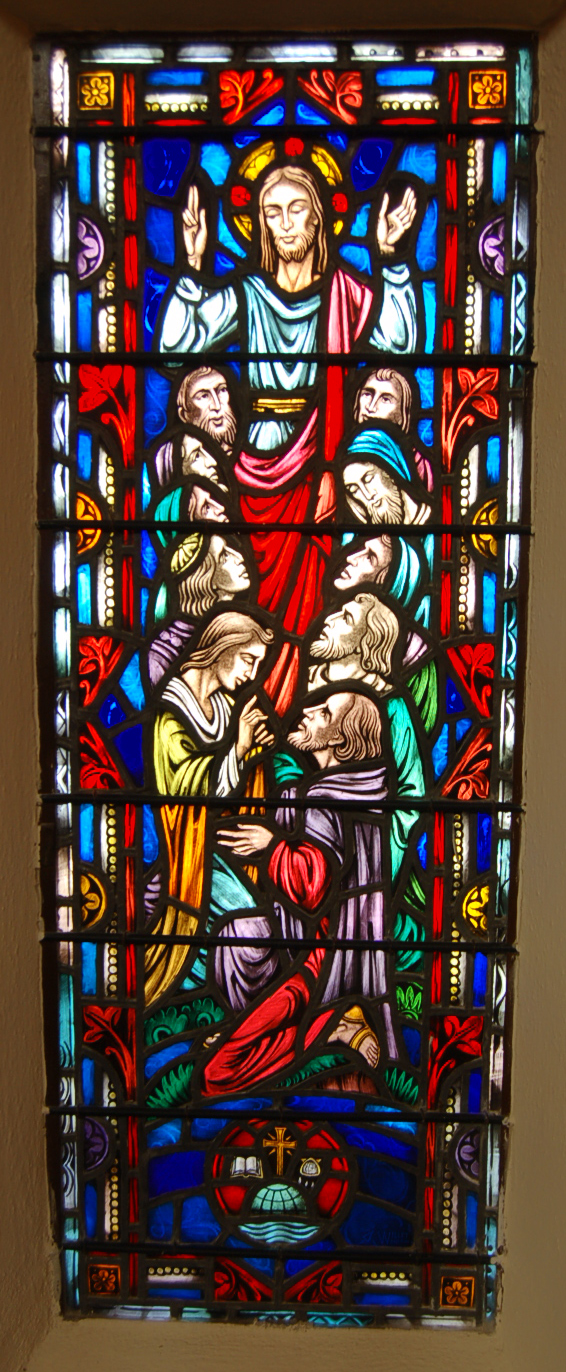
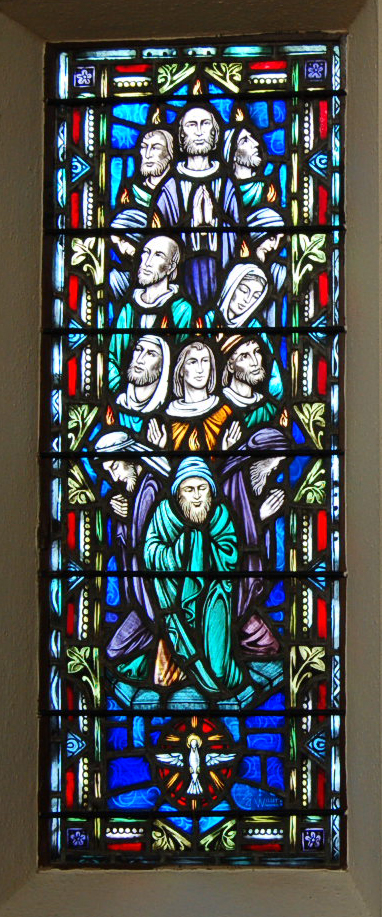
History 101.10
The below article was written by Dr. Eugene Murphey and was published in The Tower newsletter of November 2005.
![]()
When the United States entered World War II in December 1941 after the Japanese attack on Pearl Harbor, I was just starring medical school at Ole Miss in Oxford. All the medical students, like others all over America, were immediately enlisted and commissioned into military service, either the Army or the Navy by our choice. We were permitted to complete our medical school training in an accelerated program and in a semi-inactive military status until graduation, and then we were commissioned again into active service for our country.
The word commision, according to Webster, implies “a certificate conferring military rank and authority, although I can assure you my authority as a green Army medical officer was very limited. Webster also defines the word as authority to act for, in behalf of, or in place of another,” and this brings us by a somewhat devious route to “Christ’s Great Commission” given to His followers after His resurrection. This is also the subject of the next stained glass window panel in the west wall of the sanctuary John’s Gospel (John 20) tells us that late on the Sunday evening after the discovery of the empty tomb, Jesus’ followers gathered together behind locked doors because of their fear of Jewish authorities. Jesus appeared before them, and after identifying himself by His crucifixion wounds, said, ‘Peace be with you. As the Father has sent me, so send I you.”‘Thus, they were commissioned to go into the world to preach the Gospel and baptize in the name of the Father, Son, and Holy Spirit. They were given His authority and command to continue to do His work in the world. This event is shown in the window panel with Jesus surrounded by His faithful disciples as He gives them their commission. This message is symbolized a the bottom of the panel by a world surmounted by tie Cross and surrounded by a banner with, on one side n open Bible signifying “The Word to be preached to the world, and on the other side a scalloped shell with falling water droplets signifying Christian baptism.
The adjoining window presents an immediately following event when the faithful were gathered to celebrate the Feast of Pentecost and were visited by the Holy Spirit who made His presence known by tongues of fire over each head. This recalled Jesus’ words (Luke 24:49) ‘I Myself will send upon you what my Father has promised.’ The window shows the gathered disciples each with the flame of the Holy Spirit above his head. The ascending dove of the Holy Spirit is seen at the bottom of the panel. The Commission Window was given in memory of Mrs. Erin Payne Serrill by Mr. H. G. Serrill. The Pentecost Window was given in memory of Mrs. Louise May Baughman by her family, and in memory of Mr. Wilburn Wesley Hunt by Mr. and Mrs. Forest Linton Morgan.
-Eugene M. Murphey, M.D.
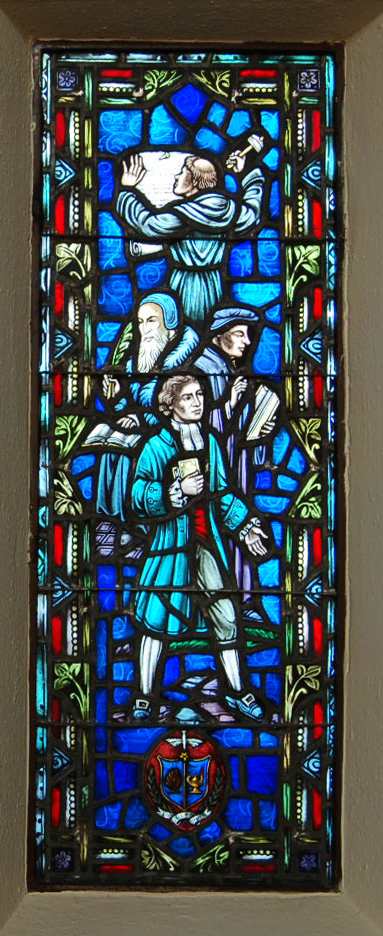
History 101.11
Written by Dr. Eugene Murphey and published, December 2005.
![]()
[responsivevoice voice=”US English Female”]
The last stained glass window in the west side wall of our church sanctuary presents a collage of four renowned persons in Protestant Church history, The Apostles, following the admonition of Jesus as depicted in the previous Great Commission window, went forth in to the world to preach the Gospel and bring all people into the fold of Christianity. Their mission was further carried out by many others through the centuries, and in later times the men shown here were powerful forces in establishing and nurturing the Christian Protestant Reformed Faith and doctrine as we know it today. This panel entitled ‘The Reformation’ shows Martin Luther nailing on the cathedral door his ninety-five theses, John Calvin writing, John Knox teaching, and Makemie preaching. These men were powerful forces in our church history and they deserve special attention and study. At the bottom of the panel appears the Great Seal of the Presbyterian Church.
This window was given in memory of William Burns Marion by his family. The next several segments in our FPC History series will deal with the large stained glass windows in the front of the sanctuary behind the chancel area, the chancel furniture, the overhead Cross, and other items of historical interest.
[/responsivevoice]
-Eugene M. Murphey, M.D.
History 101.12
Written by Dr. Eugene Murphey and published, January 2006.
![]()
[responsivevoice voice=”US English Female”]
On a bright sunny day the three chancel area lancet windows at the front of our church sanctuary present a brilliant array of colors and a tremendous amount of biblical and church history that never fails to move me to say, ‘Thank you, Lord, for the message of faith and inspiration that this display gives us!’
When the mock-up for the windows was first presented to our church committee for approval in 1970, our minister Reverend Bob Smith suggested to Mr. Willet, the designer, that perhaps the windows needed a little more red in them. An immediate reply explained that red is too stimulating and aggressive, and is held to a minimum to allow the blues and greens to dominate and produce a more peaceful and tranquil effect on viewers. Whatever the color combination may be, it certainly produces in the window panels a powerful visual impact that is both attention-getting and inspiring.
The dominate Christ Figure at the top of the middle window repeats our Lord’s great commission previously noted in one of the sanctuary side windows: ‘Come unto Me, all ye that labor and are heavy laden, and I will give you rest. Take My yoke upon you.’ (Matthew 11:28-29). Jesus’ ascent into Heaven is signified by a curved rainbow and stars as well as the four-winged figures from the Book of Revelations above his head representing the four evangelists- the man, Matthew; the lion, Mark; the ox, Luke; and the eagle, John. At the top of each adjoining lancet window are the other symbols of the Holy Trinity: on the left side, the hand of God the Father extended in blessing and on the right, the descending Dove of the Holy Spirit.
Time and space do not permit full discussion of the other features of these three window panels, but they will be covered in future history articles. In the meantime, please take a few minutes while you are in the sanctuary before or after service to approach chancel area and look closely at the myriad details of these beautiful windows. All three windows were originally, and continue to be, dedicated to the Glory of God. The left lancet was also dedicated in honor of Elder C. Richard Bolton; the middle lancet in honor of one of our long-term former ministers and his wife, Dr. and Mrs. S.E. McFadden; and the right lancet in memory and honor of all those who have served the church in its music and education ministry.
[/responsivevoice]

History 101.13
The below article was written by Dr. Eugene Murphey and was published in The Tower newsletter of March 2006.
![]()
[responsivevoice voice=”US English Female”]
In the previous church history segment, we briefly discussed the three tall lancet windows in the front wall of the church sanctuary with the dominant central figure of Christ as the Head of the Church surrounded by figures representing his disciples, the descending Holy Spirit and Hand of God. Below these and to the sides of the Christ figure and a collage of human figures representing all the peoples of the world who look to Christ as their leader and savior. Many different occupations, age and ethnic backgrounds are shown, nearly all looking toward Christ and responding to His command not only to follow Him but to ‘take up your yoke and follow Me.’ The oxen yoke for pulling is seen below the Christ figure. This means that as Christians we are not to be just passive followers but that we must work in and for Him in carrying forward of His Kingdom on earth. Small side figures show parables of the good Samaritan and the sower of seed. Below them are the Acts of Mercy (Matthew 25): feeding the hungry, giving drink to the thirsty, welcoming the stranger, clothing the naked, visiting the sick and imprisoned.
In the panels below Christ, the artists at Willett Studios who were responsible for the stained glass windows inserted a number of people who have followed His command and hold important places in our church history. These include such well-known names as David Brainerd, Sheldon Jackson, Dr. Livingston, John Leighton Stuart, Motte Martin and William Carey, all persons of tremendous faith and dedication. Ina larger segment we will try and provide more information about these powerful figures. Several of them are shown with persons of different races and nationalities to whom the administered.
At the bottom center panel, we see a number of different church buildings representing the multitude of branches of the Christian Church Universal. This is fronted by the seal of the World Council of Churches with the ship of the Church and its cross-topped mast. The figure at the left is a blacksmith beating a spear into a plowshare. below him is the seal of the United Nations, the UN buildings and a spiked cross carried by Crusaders so they could plant it wherever they wanted to pray.
Also of special interest is the figure at the bottom right of a space-suited astronaut backed by stars and an atomic symbol. he is presumably walking on the moon with the inscription, ‘Go Ye Unto All The Wolrd.’ This confirms that our stained glass windows are designed and constructed soon after that famous first moon landing, and also established the fact that Christ’s commission no longer only to our planet Earth but to all God’s universe.
[/responsivevoice]
-Eugene M. Murphey, M.D.

History 101.14
The below article was written by Dr. Eugene Murphey and was published in The Tower newsletter of April 2006.
![]()
[responsivevoice voice=”US English Female”]
As we continue to explore the history of our church, both local and universal, we have for the past thirteen segments looked at the history and meaning of the stained glass windows in the sanctuary and hallways. In the last window near the rear of the sanctuary on the west side, we previously noted several men who were highly important in the growth and development of Christian faith and our denomination.
One of these men was Francis Makemie who has been called ‘The Father of American Presbyterianism.’ He is seen in the middle of the window panel. He was a native of Northern Ireland, born in the mid 1600;s, educated in Scotland, ordained in Ireland and shortly afterward sent as a missionary preacher to the colonies. he settled in Virginia but traveled and preached extensively along the eastern seaboard, especially from North Carolina to Maryland and also into the West Indies. His marriage to a wealthy landowner’s daughter probably gave him the financial means to carry his work farther afield. In March 1706 Makemie and a small group of ministers organized the first presbytery, probably meeting in the Buttonwood Church built in Philadelphia in 1704. Makemie was elected the first moderator, and he and the other ministers – and later elders – are reported to have set about the arduous task of finding clergy and financial support from England, Scotland, and Ireland. Incidentally, this should give our pastoral search committee reassurance that even in 1706 the job of finding a minister was not easy.
In 1708 Francis Makemie went on a preaching mission along the upper east coast and into New York where he was arrested by then-governor Lord Cornbury for preaching without a license although he had a valid license for other colonies. he was confined to jail for two months and although finally acquitted, he was forced by the governor to pay heavy court costs. He died the following year probably due in part to the stress of his trial and imprisonment. We are told that in spite of his death, the presbytery prospered and grew in size and influence due both to Makemie’s leadership and to the rapid increase in immigrants who were mostly of Scotch and Irish origin.
If you have not read the current (March) issue of Presbyterians Today, I encourage you to do so. On the cover is a great picture of our current Moderator of the General Assembly, Rich Ufford-Chase, who was also our guest minister several weeks ago. An excellent and informative interview by Editor Eva Stimson is also included inside. In addition, Associate Editor John Sniffen has written an intensely interesting and informative article entitled ‘Presbyterians in America,’ in anticipation of the celebration later this year of the 300th anniversary of the first presbytery in America. Much of the historical information about Francis Makemie in y above discussion was summarized from John Sniffen’s article which carries the following title and subtitle: ‘1706. 300 years ago at the first presbytery meeting in America, our ancestors put aside differences in favor of unified witness.’
[/responsivevoice]
-Eugene M. Murphey, M.D.

History 101.15
The below article was written by Dr. Eugene Murphey and was published in The Tower newsletter of May 2006.
![]()
[responsivevoice voice=”US English Female”]
A previous church history segment in The Tower mentioned the name of Sheldon Jackson whose picture appears in the middle stained glass lancet window in the south wall of the chancel area. He is an imposing figure in his gray fur parka hood, and he is shown with his hand resting in blessing on the shoulder of a native Alaskan Eskimo.
Most of us may never have heard of Sheldon Jackson, but we should now recognize him as one of the great Christian missionaries in our church history. He was born in Miniville, New York in 1834, graduated from Union College and later from Princeton Theological Seminary in 1858, and then was ordained a Presbyterian minister. Almost immediately he became a missionary, and his reputed energy and enthusiasm carried him into much of the mid-West and Rocky Mountain states, where he is estimated to have established over one hundred churches and missions and to have traveled over one million miles in his work.
Eventually, the Reverend Dr. Jackson carried his mission work into Alaska territory where he established many training centers and schools for native Alaskans. His extensive travels in Alaska, and even into Russian Siberia, led him to become concerned about the preservation of native culture, art, and lifestyles. This led to the establishment of the famous Alaska State and Sheldon Jackson Museum in Sirka, Alaska.
Jackson also involved himself in politics to further his goals of betterment for the Alaskan people. United States President Benjamin Harrison became his friend and helped pass legislation that assisted in setting up legal authorities and commissioners for the territory as well as providing federal aid for education. His devotion to the educational and spiritual growth of native Alaskans continued undiminished until his death in 1909.
[/responsivevoice]
-Eugene M. Murphey, M.D.

History 101.16
The below article was written by Dr. Eugene Murphey and was published in The Tower newsletter of June 2006.
![]()
[responsivevoice voice=”US English Female”]
Missionaries in our universal Christian and many-faceted Presbyterian denomination have literally covered the world in the last three centuries in their efforts to carry the good news message of Jesus Christ to all people. Their stories an as varied as their names and ethnic backgrounds, but probably none are more exciting and intriguing than those of the men whose faces appear in the central lancet stained glass window in the chancel area of our church sanctuary. Last month we discussed the middle figure in the panel, Rev. Sheldon Jackson. Now let us consider the next person above him, Dr. David Livingston, one of the first Caucasian men to penetrate the African continent along with Robert Moffat who immediately preceded him in missionary efforts in Africa. Dr. Livingston later married Moffat’s oldest daughter Mary in 1844. She bore six children, with one dying in infancy, and she died in Africa in 1862.
Dr. Livingston was born in Blantyre Lanarkshire, Scotland in 1813 to parents of meager means but strong religious faith and members of the Congregational Church. Early on he became intrigued with the missionary work of Henry Martyn among the Mohammedans and Charles Gutslaf, medical missionary to China. He then met his future father-in-law, a pioneer African missionary, and this led Livingston to pledge himself to service in the so-called ‘Dark Continent.’ He was ordained a missionary in Albion Street Chapel, London, November 8, 1840.
The story of Dr. Livingston’s travels, explorations, and missionary work is far too extensive for repetition here, but it is sufficient to say that he accomplished much good in the name of Jesus Christ. He was tireless in his efforts and
often faced unbelievable trials in carrying out his work. His repeated exposure to disease, pestilence, and starvation eventually reduced him to ‘a living skeleton.’ It was in this condition that in 1871, after being lost in the interior for a time, he was found by New York Herald journalist Henry Stanley who was sent to find him. You probably remember the oft-repeated story of their meeting when Stanley approached, lifted his hat and said, ‘Dr. Livingston, I presume?’ The emaciated, grey-haired missionary replied, ‘Yes’, when Stanley said, ‘I thank my God I am permitted to see you,’ Dr. Livingston is said to have replied, ‘I feel thankful that I am here to welcome you.’
Dr. Livingston not only was intensely dedicated to his missionary work in Africa but also responsible for making many important geographical observations that he sent back to England. His efforts were also instrumental in opening the continent to free trade and exposing the injustice and horror of slave trading.
-Eugene M. Murphey, M.D.
( hover image )
( hover image )
History 101.17
Missionaries depicted in the Chancel Window
The below article was written by Dr. Eugene Murphey and was published in The Tower newsletter of July 2006.
![]()
[responsivevoice voice=”US English Male”]
The world-wide-web is a great source for all kinds of information, some good and some not so good, as was quickly appreciated when trying to find biographical information about one of the historical figures in the middle stained glass lancet window in the church chancel area. Motte Martin proved a real challenge when the computer search engine found 123,000 possible bits of information related to that name or its numerous variations. After plowing through several thousand items, mostly with no connection to the person sought after, I learned that ‘the real Motte Martin’ lived in Marlin, TX and as a youth joined the First Presbyterian Church there in 1894. Eight years later he became one of the earliest missionaries to the Congo. Further information about his life and work may be provided later when a query to the Mission Board in Atlanta is answered. It is of interest that Martin’s home church in Marlin started out as a mission church in 1852 and met for several years in the local Falls County Court House. The church pulpit was hoisted into the rafters of the courtroom whenever court was in session.
Another figure in the same window is David Brainerd, who became a missionary to the Native American Indians in eastern Pennsylvania, New Jersey, and New York. Born in Connecticut in 1718, he lived only twenty-nine years, dying at this early age of tuberculosis. However, in his short ministry, he is said to have had tremendous Christian influence on large numbers of the people he served. Brainerd was not a finished scholar, having been expelled early from Yale University because of criticizing a professor and also being briefly associated with a rebel religious group. Nevertheless, he kept a voluminous diary of missionary work and beliefs. His published Life and Diary of David Brainerd is highly recommended reading for Christians everywhere.
The last person depicted in the center stained glass panel is William Carey, better known to most of us as the namesake of William Carey College in Hattiesburg, Ms. It is one of several schools in this country named for this missionary. Carey was born in England in 1761 in the small Northamptonshire village of Paulerspury and, along with his parents, was a member of the Church of England. At age eighteen he changed to the Congregational Church and then in 1783 was baptized and joined the Particular Baptists. He worked as a cobbler’s apprentice and schooled himself on the side, by age twenty-one learning four languages – Italian, Hebrew, Greek and Latin – and working on Dutch and French. His studies led him to see the world’s need for Christ; in the quiet of his cobbler’s shop, he heard and accepted God’s call. He is reported to have surrendered to the call crying out, ‘Here am I, send me!’
Cary’s missionary efforts first met with disinterest and lack of enthusiasm, but eventually, his dedication and dogged persistence led to the formation of the well-known support organization, the Missionary Society. Cary wrote and published his famous Enquiry Into the Obligations of the Christians to Use Means for the Conversion of the Heather and dedicated all proceeds from the book to the Society because he did not have any other money to contribute.
In 1793 Carey went to India as a missionary and served there forty-one years. He survived the disappointment of no converts in the first seven years he was there but lived to see India open its doors to Christian missionaries and the scriptures translated into forty languages. He died in 1824 at the age of 73 without returning to England.
[/responsivevoice]
– Eugene M. Murphey, M.D.

History 101.18
Written by Dr. Eugene Murphey and published, August 2006.
![]()
[responsivevoice voice=”US English Male”]
The last, but certainly not the least important, missionary figure in the center stained glass lancet window is the chancel area of the church sanctuary is that of John Leighton Stuart, which is seen just below Christ and the oxen yoke symbol.
Stuart was born in China in 1876 to American parents and was educated in the United States but returned to China as an educational missionary; he first served as a teacher at the University of Nanking, then a small Christian missionary institution. His successful work there as an educator and administrator led him to be selected in 1919 as the first president of Yenching University, previously known as the University of Peking.
In 1946 Stuart was named United States Ambassador to China, but the Communist take over of China three years later was undeservedly blamed on him and, he was in political circles lampooned and satirized by the Communist leader Mao Zetong. As a result of these adversities, his many great contributions to education and Christian missionary work have been suppressed and would have been forgotten had it not been for Stuart’s friendship and collaborations with William Bacen Pettus, a Mobile, Alabama native and boyhood friend of Stuart. A 1905 graduate of Columbia University in Missouri, Pettus and his wife went to Shanghai, China in 19056, and he soon began an intensive study of Chinese language and culture, receiving his Mater’s Degree at the University of Nanking in 1910. Because of his intense interest in the Chinese language, literature, and culture, the Foreign Mission Board appointed him president of the College of Chinese Studies in 1916. He later developed this small college into a world center for Chinese studies for foreign nationals in China.
Through their respective institutions, the collaboration of Stuart and Pettus, in educating the Chinese about modern Western education, religion, and culture, and Westers in Chinese language and civilization resulted in the production of numerous outstanding diplomats, journalists, scholars, and professors in both worlds. We have Claremont College in California to thank for preserving in their archival collection and publicizing the tremendous works and contributions of these two important men in our church and secular histories.
[/responsivevoice]
-Eugene M. Murphey, M.D.

History 101.19
Written by Dr. Eugene Murphey and published, September 2006.
![]()
[responsivevoice voice=”US English Male”]
In two earlier church history lessons (FPC History 101.12 and 101.14) we briefly mentioned the stained glass window on the west wall of the sanctuary and gave some biographical data about Francis Makamie. Also included in the window are three other famous men in the history of the Protestant Church: Martin Luther, John Calvin, and John Knox.
The Encyclopedia Britannia tells us that Martin Luther was born in Eislben Germany in 1483 and died in the same area sixty years later. Early on he studied philosophy and law and later entered an Augustinian monastery, where he was ordained in 1507. Then he became a professor of biblical studies at the University of Wittenburg. During a trip to Rome in 1510, he is reported to have been shocked by the corruption of the clergy and was greatly disturbed by the then-popular religious teaching in divine retributive justice. He decried the selling of indulgences and other abuses in the church. He was able to develop his own belief of justification by faith, that our salvation is granted as a gift though Gog’s grace. He developed a panel of Ninety-Five. These questioning Roman Catholic teaching and practice and demanding reform. Legend has it that in 1517 he nailed these to the Wittenburg Cathedral door ‘with hammer stokes that echoed throughout all Europe’ as pictured in our window, although some modern historians think he may only have given copies to the Archbishop of Wittenburg and friends. Nevertheless, as a result of his actions, he was excommunicated by Pope Lei IX, and the Diet of Worms declared him an outlaw. His break with the Roman Catholic Church later led him to found the Lutheran Church.
In exile after his altercation with the Roman Catholic hierarchy, Luther lived incognito in Wattsburg under the assumed name of Junker Jorg (Knight George). There, in 1525 he married a former nun and raised six children. He is also credited with translating the Bible into German, a task ‘long regarded as the greatest landmark in the history of the German language.’ This translation from Greek to German of the New Testament is reported to have been accomplished in eleven weeks. He also sanctioned the production of the Lutheran or Augsburg Confession by Philipp Melanchthon in 1530. The remaining window figures, John Calvin and John Knox, will be discussed in later history articles. Your suggestions for other church history items will be welcomed.
[/responsivevoice]
-Eugene M. Murphey, M.D.

History 101.20
Written by Dr. Eugene Murphey and published, October 2006.
![]()
[responsivevoice voice=”US English Male”]
In concluding our history of the stained glass windows in the church sanctuary, we return to the last panel in the west wall. Last month we discussed Martin Luther, reputed Father of the Christian Reformation. The remaining two figures are John Calvin and John Knox, side by side and central in the panel with Martin Luther at the top and Francis Mackamie at the bottom.
John Calvin (or correctly Jean Cauvin) was born in the Picardy region of France in 1509, and according to the Encyclopedia Britannica, first studied religion at the University of Paris and later law in schools in Orleans and Bourges. Returning to Paris in 1531, he studied the Bible and soon became involved with a movement that emphasized the Reformation tenet of salvation by grace, not by works. Government forces opposed the radical movement which led Calvin to move to Basel, Switzerland, where he wrote the first edition if the Institutes of the Christian Religion. His reputation grew, and he moved to Geneva to establish and further his theology. Once again he was opposed by city authorities and expelled from the city in 1538. However, three years later he was able to return. His Ecclesiastical Ordinances, which included enforcement of sexual morality and abolition of Catholic ‘superstition,’ were accepted by the city council. In his later years, Calvin was pastor and headmaster of the Genevan Academy where his sermons, writings, and biblical interpretations became the basis of Calvinism. Calvin died in Geneva in 1564.
John Knox, the father of Presbyterianism, is shown in the window panel on the right. He was born in Haddington, Scotland in 1514. He was trained for the priesthood at St. Andrew University in Edinburgh and ordained in 1540, but soon began to embrace the beliefs and teachings of John Calvin. While in Edinburgh he became associated with a group of Protestants who over and fortified St. Andrew’s Castle. They were soon overcome by a contingent of French Catholics who carried them away into slavery. Two years later the English government intervened, and they were released. Knox returned to England and spent four years preaching until Mary I, a staunch Catholic, ascended the throne. Alarmed by the possibility of further reprisals Knox fled to the continent where he served as pastor at Frankfurt au Main and Geneva. He was able to return to Scotland in 1559 when an alliance was made with Elizabeth I of England. She feared the French would gain control of Scotland, which was ruled by Mary, Queen of Scots, a Catholic. Knox is said to have survived several conflicts with Mary over their opposing religious beliefs but was able to spend his remaining years establishing the Presbyterian Church. He died in Edinburgh in 1572.
[/responsivevoice]
-Eugene M. Murphey, M.D.

History 101.21
Written by Dr. Eugene Murphey and published, November 2006.
![]()
[responsivevoice voice=”US English Male”]
A number of church members and Tower readers have kindly expressed appreciation for and interest in the previous FPC History articles about our beautiful stained glass windows. Some have also encouraged further presentation of information about our religious heritage and local church history, hence this and following articles beginning first with a brief look at the history of music in church worship and particularly about music in First Presbyterian Church, Tupelo.
Historians tell us that there is evidence of music being used in religious ceremonies of the ancient Greek, Syrians, and Hebrews. A few remaining examples of Greek religious music indicate that it was primarily monphonic unison melody without harmony. Antiphonal singing (back and forth singing) of psalms was used in the ancient Syrian churches and monasteries and Jewish temples saw or heard the use of psalmody verses based on the Hebrew “Book of Praises” or Biblical psalms. Later hymns followed the psalms using melodies from earlier chants, and the using lyrical portions of the Bible. The first written Catholic Church developed the Canticle using lyrical portions of the Bible. The first written chants were associated with Pope Gregory and are now known as Gregorian Chants.
As far back as the Middle Ages, the Catholic Church developed worship service into the Mass which was divided into two types, the Proper Mass and the Ordinary Mass with music for the former type including forms such as Introit, Epistle, Alleluia, Evangelium, and Communion. The Ordinary Mass might include the Kyria Eleison, Gloria, Credo, Sanctus, and Agnus Dei. As time passed the music of the Mass became more complex, and understanding of the words and text as well the music so difficult that some singers balked at the performance. Church leaders of the Council of Trent addressed the problem and the first official catechism was formulated. This specified that the music for worship be within reasonable bounds so that the congregation members could participate in it. The musician, Palestrina, was commissioned by Pope Marcellus to simplify the church music and he did a masterful job of retaining the beauty of the melodies and at the same time making the words understandable and meaningful.
Later in the 17th and 18th centuries, many of the world’s greatest composers contributed to the Mass. Bach, Monteverdi, and Scarlatti all produced great religious musical contributions. Handel created the oratorio and his most famous work, ‘ The Messiah.’ Schultz’s. ‘The Seven Last Words’ and Mozart’s eighteen masses should also be mentioned although it should be noted that some of Mozart’s works were so long that they could not be fitted into a conventional church service. Hayden also made a great contribution with fourteen Masses. His most famous was an oratorio ‘The Creation.’
A greater freedom of musical style and form was introduced into church music in the 18th century. This was often called the ‘Liturgical Movement’ and saw a simplification of music and better integration into the liturgies so as to better meet the needs of the pastors and their flocks. This change was carried into the 19th and 20th centuries with religious texts being combined with folk melodies as we see into the hymns ‘Amazing Grace’ and ‘There is a Fountain.’
So-called contemporary Christian music was born in the latter part of the 20th century and is on-going now with sometimes almost unrecognizable relationship to the familiar church hymns. The addition of band instruments and electronic musical devices is also a relatively new development but all are hopefully devoted to Christian beliefs and worship in an ever-changing world.
[/responsivevoice]
-Eugene M. Murphey, M.D.

History 101.23
The below article was written by Dr. Eugene Murphey and was published in the ???? 20?? Tower newsletter. Dr. Murphey gives a history of these missionaries and their importance to the Presbyterian church. The below is but one part of Dr. Murphey’s research. Additional articles will be added soon!
![]()
[responsivevoice voice=”US English Male”]
Church music has always been an important part of the worship service at First Presbyterian Church, Tupelo. The musical instruments used and the participants in the music program, both choirs, and congregation, have provided us with many interesting and fascinating bits of historical information that should be shared with our members.
Thanks to Edith Ruff Thomas, Louise Nanney Godwin, and Catherine Hunter Sadler, who have helped preserve much of our FPC history, we learn that our present church building was constructed almost from the ground up after the disastrous tornado of 1936 destroyed much of the original building. The organ in the chancel area then located at the north end of the sanctuary survived without major damage, but the organist and choir director, Miss Katie Topp, and her twin sister, Miss Clara, rescued the organ pipes from the debris and carried them to their home and his them under their bed. We think that the pipes were later reincorporated into the original instrument which remained in use until the current Letourneau Organ was installed in 1996. This is one that currently is so masterfully played by our organist, Dr. Ray Harris.
Very little is known about church music and instruments in the original church building then located on the corner of North Church Street and Walnut Street. That church congregation later merged with the Cumberland Presbyterian Church then located in the next block south on Church Street across the street from the present post office. The merged churches became First Presbyterian Church at its present location on Jefferson Street. We do know that the first pipe organ for the church, a Hook and Hastings instrument, was purchased in 1905 soon after the merger and remained in use except for refurbishment and enlargement by Dr. Norman Ryan of Duke University in the 1960’s.
Our church organ survived another disaster when the church partially burned in 1951. The church organ was not damaged but had to be removed and restored until reconstruction of the building was completed.
The church members primarily responsible got overseeing the selection and installation of our present organ was chaired by Margaret Gratz, who assisted Dr. Ray Harris, Dr. Bruce Lesley, Chauncey Godwin, Beth McAuley, Doyce Deas, and Edith Thomas. In the dedicatory program for the organ on September 29, 1996. Dr. Bruce Lesley, our former choir director, said: ‘Our new Letourneau organ can only serve to enhance our worship and praise of God through music well into the next century. Let us give thanks to God, that as we dedicate this newest voice among us, it will speak of his great Glory in a language that transcends words for all who worship in this beautiful place.’
Dr. Harris in the same program stated, ‘This new organ we are dedicating today is an exciting instrument of praise. Many individuals have contributed to make this organ a reality. It will represent for years to come the offerings of praise not only of this generation but also of those who have gone before. In installing it, we are not indulging in art’s sake. We are giving a gift to God – not a mediocre gift, but a gift of our best.’
[/responsivevoice]
-Eugene M. Murphey, M.D.

History 101.25
Written by Dr. Eugene Murphey and published, January 2007.
![]()
[responsivevoice voice=”US English Male”]
The previous church history segment dealing particularly with our local church music program. I failed to note that the terrible tornado on April 6, 1936, happened on the night that the choir was practicing its Easter music program in the chancel area of the sanctuary. None of the choir members were injured, but they had to make their way out of the remains of the building in total darkness and as related earlier choir director Katy Topp, and her twin sister Clara later returned and rescued the pipes from the church organ. This serves to remind us that the church choir members are a specially dedicated group of people who will go to unbelievable lengths to serve the Lord and our church with music.
Several of those church members who survived the tornado were still singing in the choir when my wife and I moved to Tupelo in 1950. A choir stalwart was A.G. ‘Rock’ Bowen, who had a wonderful bass voice and, in spite of vision problems in his later years, continued to sign in the choir until he was ninety years old. He once asked our daughters, Jean and Margaret, then about five and seven, to stand in the chancel area and accompany him by ringing brass bells while he sang ‘Hear Them Bells.’ We still have the bells as mementos of that occasion. Another who came to Tupelo just after the tornado but continued singing until the mid-1950’s was Mrs. Daisy Purnell, mother of the late Ray Purnell and grandmother to Lee Walsh and Hugh Purnell.
Alice Bishop Rogers and Ann Bishop Godwin, both current choir members remember their parents, Erskine and Annie Laura, singing in the choir. Alice recalls playing the piano for her father who was diligently practicing a short solo ha had in an Easter program, ‘The Seven Last Words.’ His part was ‘I thirst!’ and just as he started to sing, Rock Bowen, thinking it was his part, jumped ahead and sang it for him. Needless to say, Erskine was devastated to miss his great solo opportunity.
Another great bass voice in the choir was the late Albert Walker, husband of Sabo Walker. He could always be depended on to hit those low notes. At the other end of the male voice, spectrum was the late Norman Wilcox, who has a wonderful tenor voice. His widow, Ruth Ann, is still a member of FPC.
First Presbyterian Church has been most fortunate over the years to have many outstanding and talented choir directors and organists, in addition to innumerable well-voiced choir members. Many of our long-term current choir and church members will remember such names as Nona Wayne Ewing, Tim Coker, Jo and Ben Orr, Wick Sparks, Larry Newman, Ken Courtney and Bruce Lesley. Our present interim director, Kathy Anderson, and our organist, Dr. Ray Harris, fall right in line with our desire and policy to have only the best in church music. Our music scholarship program has also provided the great opportunity of importing wonderful musical talent from educational institutions in the area. The students who have come to us through this means have not only been a great addition to the music program but also have set a high standard of musical excellence for all regular choir members.
The music program at FPC continues to be a very important and integral part of Christian worship, and it is our hope and prayer that it will continue to grow and develop to the glory of God.
[/responsivevoice]
-Eugene M. Murphey, M.D.
History 101.26
Written by Dr. Eugene Murphey and published, March 2007. Dr. Murphey gives a history of the missionaries displayed in our Chancel windows and their importance to the Presbyterian church.
![]()
[responsivevoice voice=”US English Male”]
The music program history at Tupelo FPC has many facets besides the chancel choir that was mentioned in some detail last month. There have been various times over the years a Youth Choir, A Presbyteen Choir, a Cherub Choir and various other named or unnamed groups that have added their collective voices to the worship services in the church.
One of the most memorable Youth Sunday services that I can recall occurred in 1970 when rock and roll music had become popular. Of course, the youth involved insisted that the music be amplified, and large speakers were placed in the church as well as outside on the front lawn. The music and program speakers were heard with no difficulty. Our younger son, Steven Murphey, played ‘Bridge Over Troubled Waters’ on the Tracker organ, and Richard McCarty gave an inspirational sermonette entitled ‘God Is A Blast!’ John Raspberry, Joey Hutto, Talley Barnes, and Alice Rogers are a few of the remembered participants. The youth group also sang the current Beatles song, ‘Let It Be’ and George Harrison’s song ‘My Sweet Lord.’ We believe that Virginia Armstrong was the DCE who was doing her best at that time to control the exuberance of the youth group.
Glen Thomas remembers another Youth Sunday a few years later when high-level amplification was again used for the service. According to Glen, several of the ‘blue hairs’ (older members with gray hear) got up and left when the music started. That particular youth group was dominated by boys – thirteen boys and two girls – who had to be monitored and controlled by more than one senior adult. Lyle Megginson, Wade Purcel, and Chris Mills were a few of the male youth members as well as two girls, Sheldon Miles and Tonya Stein.
Music instruments of all types have been used and are still used at FPC, and there have even been small symbolic groups providing a variety of sacred music. A ‘baby grand’ piano was donated to the church about sixty years ago by Mrs. Albert (Mable) Medlin, and this instrument was in the chancel area for several years. It was later moved to the Fellowship Hall assembly room because of space problems in the choir area, and the present upright piano just below the chancel was purchased to replace the larger instrument.
Another outstanding contribution to FPC’s music program has been the Hand Bell Choir which has been conducted by several church members of the year. Jo Orr, then choir director, conducted the first handbell group which included Nancy Ingram as a pioneer member. Jo was followed later by music director Ken Courtney, More recently Bob Lence and currently our interim choir director, Kathy Anderson, have made great special music with the bell ringers. Bob Lence has also provided his expertise with the Scottish bagpipes, kilted and all, for special church historical events. Bob’s wife, Sheree Lence, an accomplished French horn player and a regular member of the Tupelo Symphony Orchestra, has also provided special music for church services.
Over the years many church members too numerous to name have organized and directed the various children and youth singing groups in providing wonderful music for worship, education, and pleasure in the church. Our present youth choir director, Melody Webb, is doing a great job in carrying on that tradition.
[/responsivevoice]

History 101.27
Tapestries and Banners
Written by Dr. Eugene Murphey and published, April 2007.
![]()
[responsivevoice voice=”US English Male”]
Anticipating the upcoming celebration of Kirkin’ O the Tartans at First Presbyterian Church, Tupelo on April 22, it seems appropriate in our church history series to consider briefly the spectacular tapestry banners hanging on the side balustrade columns in the sanctuary. These six expertly handmade needlework banners representing the great seals if our denomination were originally suggested by Edith Thomas and members of the Worship Committee, then approved by the Minister and Session. They were specifically commissioned by our church in 1991, then designed and rendered by Mrs. Sidney Bates, a noted needlework artist living at that time in Memphis. Unfortunately, we believe this talented lady is now deceased. The banners were hung in the sanctuary in 1992.
The six tapestries specifically depict the seals of John Calvin, the Church of Scotland, the Cumberland Presbyterians Church, and the Presbyterian Church in the United States of America, (the Presbyterian Church (USA)). They help to remind us of our church’s Christian Scottish and Reformed heritage along with the various associated elements in Presbyterian Church (USA) hierarchy. Many visitors both past and present attending services in our church have been extremely complimentary of the banners and have often expressed interest in duplicating them in their church homes.
Other equally handsome banners with more biblical themes are found in the church narthex (entranceway inside the main front door) and in McFadden Reception Hall to the rear of the sanctuary. The narthex tapestry represents Jesus and his Disciples. The others from left to right represent the Old Testament, the Church and Crucifixion, and finally the New Testament. Limited space here does not permit a detailed description of the numerous pictorial elements in the biblical tapestries not the many church members to whom the tapestries were dedicated as memorials or honorarium, but perhaps at a later time, this information can be published again in The Tower or in another dedicatory booklet.
The next time you enter the church and move into the sanctuary or the reception hall, please take a few minutes to examine and enjoy the banners and tapestries that are an important part of our Christian faith journey and heritage.
[/responsivevoice]
Dr. Eugene Murphey, M.D.
History 101.28
Written by Dr. Eugene Murphey and published, May 2007.
![]()
[responsivevoice voice=”US English Male”]
Church furnishings may not sound like a very interesting subject for consideration in our local church history series, but if you pause to think about it, there are many objects around our church that are not only vital to our Christian faith and worship but also have a history that should not be forgotten. In previous articles, we have already considered the beautiful stained glass windows, the musical instruments, the banners and wall hangings. Now let’s look at other on=bjetcs that we often see but perhaps do not consider why they are here in the church or where they came from.
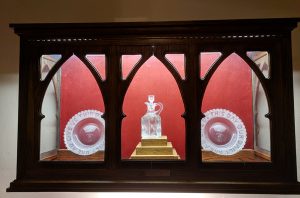
Below the display case is an antique Holy Bible that for many years was used on the sanctuary lectern for scripture reading at every church service. The aged Bible published in 1876 by A.J. Holman Company, Philadelphia, Pennsylvania, has become very fragile, so it is kept in the glass-topped chest to help preserve it, hopefully for generations to come. Another Bible of probably equal age may be seen in a protective case in the entrance hall to the Fellowship Hall across from the church library.
The Bible case rests on a beautifully ornately carved dark wood chest that once served as the communion alter in the chancel area of the sanctuary. An interesting story surrounds this alter piece in that it was donated to the church many years ago by the late Mrs. Roger Friou as a memorial to her deceased husband. It was used to hold the communion elements until the church sanctuary was renovated in the late 1960’s. Our noted consulting architect, dr, Arland Dirlam from Massachusetts, insisted that in a gothic style sanctuary such as ours the communion furniture piece should be an open table, not an altar. His recommendation was accepted unanimously by the Session of which I was then a member, and I was given the great privilege of visiting with Mrs. Friou to explain our action and get her approval. Needless to say, it was not an easy task but after much discussion she reluctantly but graciously accepted the change with the understanding that the chest (alter) would be placed in another area of the church appropriate to her husband’s memory – hence its present location in the narthex where it is a very striking piece of church furniture.
It reminds me and others of the generous gift of the Friou family every time we pass it. This bit of history should also help to remind us that gifts to the church whether memorial or otherwise are dedicated to the glory of God and His Church, and are no longer controlled by the giver. A current example is the many stained glass windows and banners in the sanctuary, all dedicated to God and to church family members both living and dead, but not visibly labeled. This information, as previously noted in a history article, is properly recorded in a public viewing book in the hallway behind the sanctuary.
Another striking item of the church furnishing is the large cross hanging above the chancel area of the sanctuary. Soon after the rebuilding of the church following the tornado of 1936, a small opaque glass lighted cross hung there and remained until the renovation mentioned earlier in this article, Der, XXXX also recommended that a larger wooden cross would be more appropriate and in keeping with the facts of Christ’s crucifixion. Mary McMillan, wife of our minister at that time, Rev. Mort McMillan, designed the cross. A local cabinet maker and wood craftsman, Lawrence Timmons and his son, were commissioned to do the job and were successful in constructing a striking wooden cross with hand-carved ends. These men also produced most of the scroll work on the lectern and extended elevated pulpit.
These are only a few more of the items in our church home that help us to remember who we are, where we came from. and hopefully, where we are going.
[/responsivevoice]
History 101.29
Written by Dr. Eugene Murphey and published, July 2009.
![]()
[responsivevoice voice=”US English Male”]
In past history segments, we have considered many aspects of our present church home and how it came to be what it is today. We have looked briefly at some of the early founding members and a few of more recent vintage. Now at the suggestion of Joe Rutherford, we would like to view in more detail some of the ‘Old members and families of the church.’
Thanks to the expert research of Lousie Nanney Godwin and the late Grace Thornton Wallace, as well as the journalistic skills of Joe Rutherford, a very complete and informative FPC history was compiled and published for the church’s centennial celebration November 5, 1967. Other contributing members of the centennial committee were Edith Thomas, Margaret Clayton, Frances Joyner, Sr, Other deceased members if the committee were Elizabeth Ballard, Marion Riley, Richard Bolton, Mrs. Durell Bolton, and Mrs. J.B. Lawson, and Reverend Bertrand Tuggle was the associate minister. On this date, the new Fellowship Hall was officially opened and dedicated. Please forgive the personal item that this writer had the distinct privilege of giving the dedicatory address.
The previous article related that Reverend Thomas C. Stuart who had earlier in 1841 organized the White Zion Church on Highway 6 to Pontotoc was instrumental in establishing the church in Tupelo in 1867 at the corner of North Church Street and Walnut Street. Among the charter members we Dr. and Mrs. J.W. Frazer, Col. and Mrs. T.A. Mitchell, Mr. and Mrs. J.R. Dickerson, Col. John Williams and Mrs. Hannah Gayle (great-great-grandmother of our present member Britt Rogers). In all, there were about twenty-five members in the original church with most of them moving from the White Zion and Pontotoc churches. The building was not complete until 1868 and until then worship services were held at First Baptist Church. The first wedding in the new building was that of Miss Antoinette Kimmons to Mr. John Clark. Miss Kimmons is said to have wanted a small wedding. A much larger wedding is said to have taken place when Mr. and Mrs. Shelby Topp were wed. Lousie Godwin claims that the longest family line in the church with five generations: McAllister, Nanney, Godwin, Godwin, Godwin.
Others in our history whose forebearers came from nearby churches founded by Rev. Thomas Stuart are Judge Glen Davidson (Pontotoc), George and Paul McCullough (White Zion), Leighton Pettis (College Hill), Lora Simms Rutherford (White Zion), and Lottie Sampler Payne and Mary Sample Terry (White Zion).
The congregation finally outgrew this original building and moved to a larger home on Church Street across from the back of the present Post Office. In April 1905 this congregation voted to merge with the Cumberland Presbyterian Church at our present location and retain First Presbyterian name and Jefferson street building which has subsequently undergone several renovations as well as extensive restorations after partial destruction by tornado and fire.
Next month we hope to look further at other people who have contributed much to the ongoing history through dedication, service and Christian love at FPC
[/responsivevoice]
-Eugene

